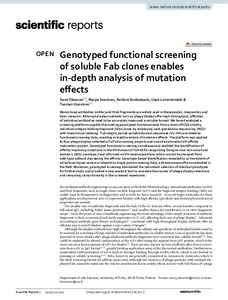Genotyped functional screening of soluble Fab clones enables in-depth analysis of mutation effects
Oksanen Sami; Saarinen Roope; Korkiakoski Anttoni; Lamminmäki Urpo; Huovinen Tuomas
Genotyped functional screening of soluble Fab clones enables in-depth analysis of mutation effects
Oksanen Sami
Saarinen Roope
Korkiakoski Anttoni
Lamminmäki Urpo
Huovinen Tuomas
Nature Publishing Group
Julkaisun pysyvä osoite on:
https://urn.fi/URN:NBN:fi-fe2025082787477
https://urn.fi/URN:NBN:fi-fe2025082787477
Tiivistelmä
Monoclonal antibodies (mAbs) and their fragments are widely used in therapeutics, diagnostics and basic research. Although display methods such as phage display offer high-throughput, affinities of individual antibodies need to be accurately measured in soluble format. We have developed a screening platform capable of providing genotyped functional data from a total of 9216 soluble, individual antigen binding fragment (Fab) clones by employing next-generation sequencing (NGS) with hierarchical indexing. Full-length, paired variable domain sequences (VL-VH) are linked to functional screening data, enabling in-depth analysis of mutation effects. The platform was applied to four phage display-selected scFv/Fab screening projects and one site-saturation VH affinity maturation project. Genotyped functional screening simultaneously enabled the identification of affinity improving mutations in the VH domain of Fab 49A3 recognizing Dengue virus non-structural protein 1 (NS1) serotype 2 and informed on VH residue positions which cannot be changed from wild-type without decreasing the affinity. Genotype-based identification revealed to us the extent of intraclonal signal variance inherent to single point screening data, a phenomenon often overlooked in the field. Moreover, genotyped screening eliminated the redundant selection of identical genotypes for further study and provided a new analysis tool to evaluate the success of phage display selections and remaining clonal diversity in the screened repertoires.
Kokoelmat
- Rinnakkaistallenteet [27094]
